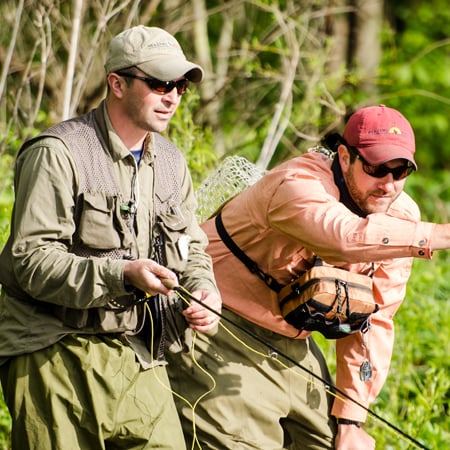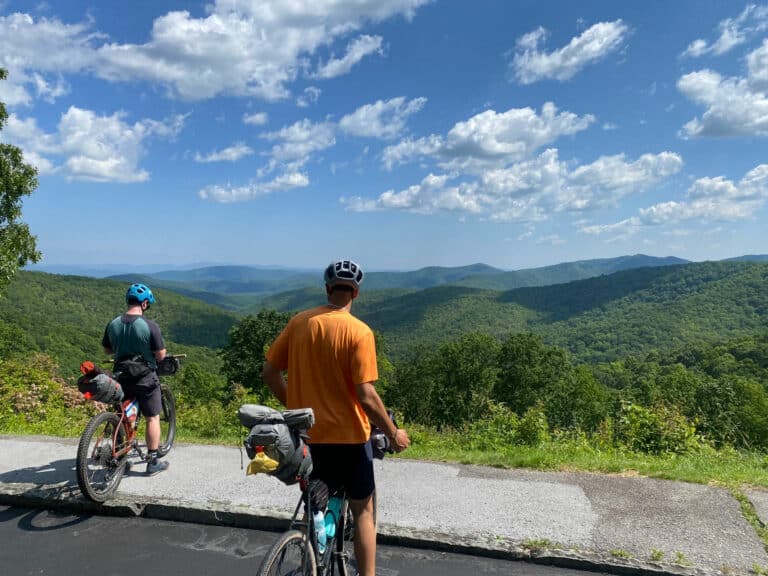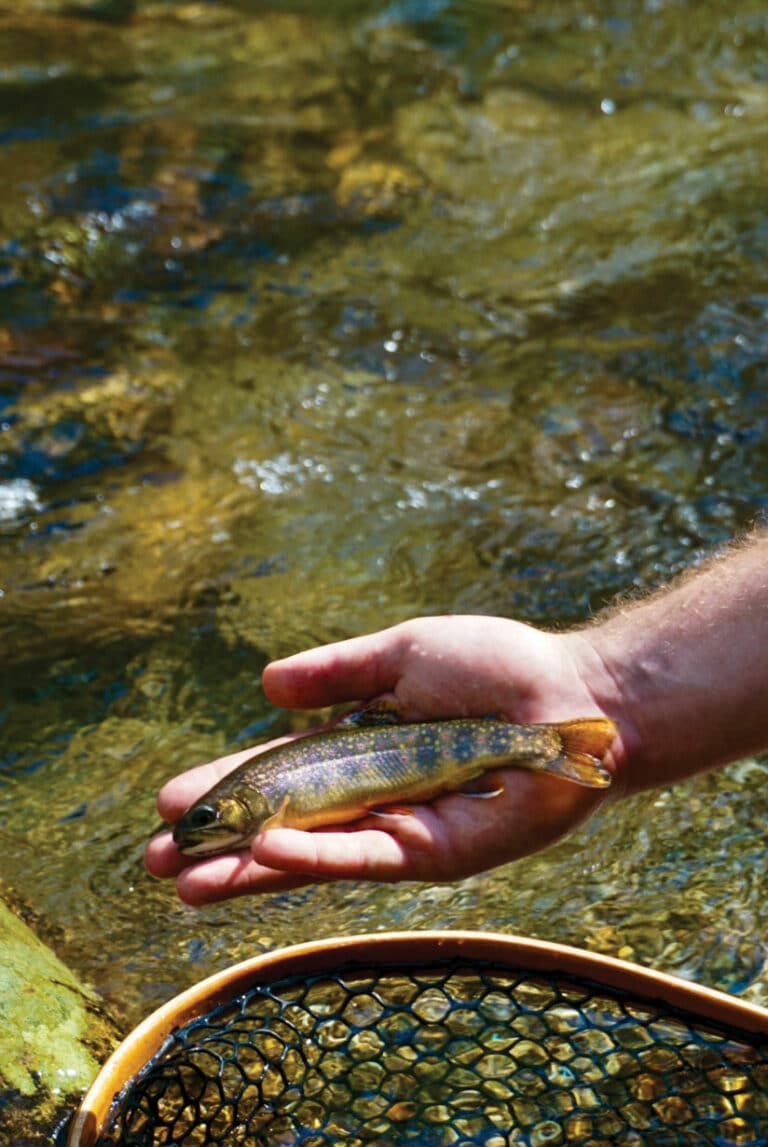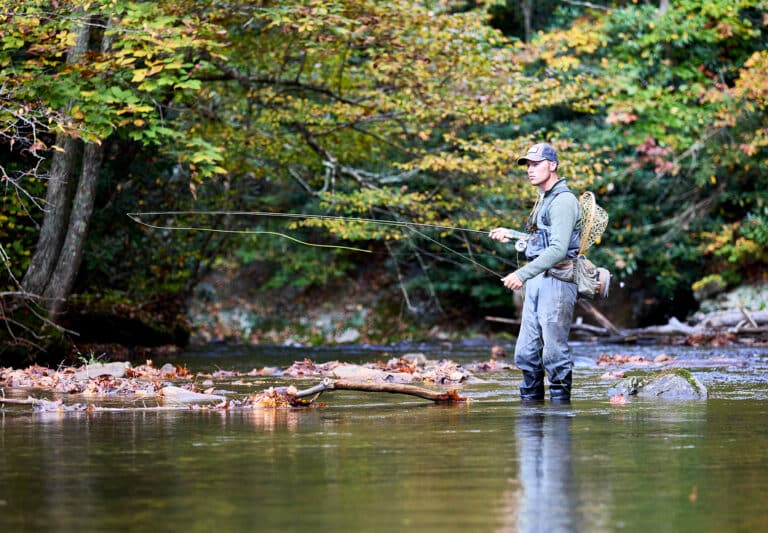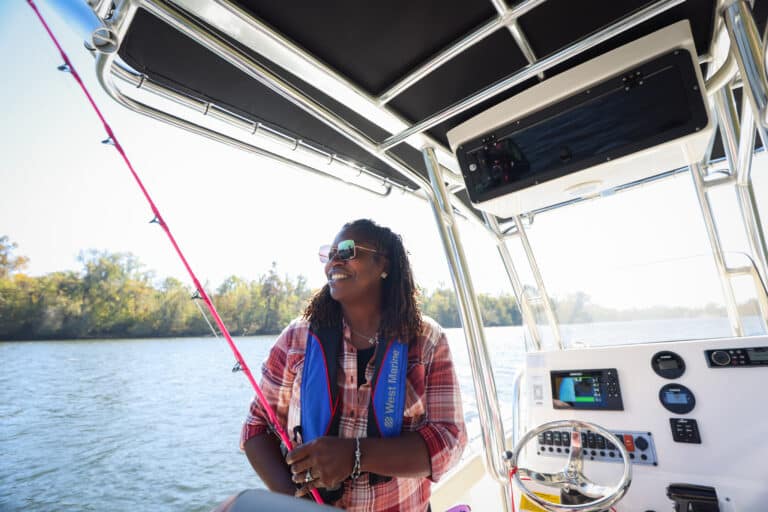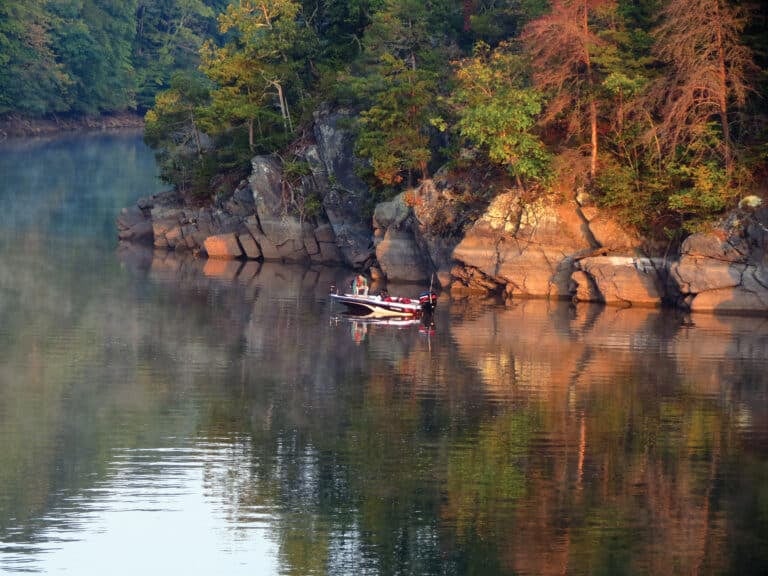When compared to other regions in the country, fly fishing for trout in the Southeast can seem like an exercise in reduction: the season is shorter, the rods are lighter, the casts are tighter, the flies are tinier. The opportunities to catch trout, however, are big. The fish can be too, but knowing where to find them can be more challenging than a quiet pick-up in heavy brush. So, we went straight to the source, asking regional fly fishing guides to share their favorite home waters from around the Blue Ridge.
NORTH CAROLINA
RIVER: SOUTH TOE
FLY FISHING GUIDE: JEFF CURTIS, Curtis Wright Outfitters
Western North Carolina does not want for trout streams, so it is easy for a river to flow under the radar in the Tar Heel State. Over 4,000 miles of cold, clear, public trout water gush from the mountains, creating a pristine habitat for wild and stocked trout. Located in the shadow of Mount Mitchell, the South Toe River does not usually pop to the top of the list when discussing trophy trout streams, but maybe it should. Jeff Curtis, co-founder of Curtis Wright Outfitters, began guiding in the region 15 years ago, and prefers the South Toe due to its wild trout and technical fishing.
“For me on the South Toe, it’s more about approach and not spooking fish—keeping a low profile and stalking fish—as it is to exactly matching a hatch,” he said.
The tributaries that form the South Toe headwaters near the Blue Ridge Parkway run cold and clean off Mount Mitchell; a lack of residential or commercial runoff makes this freestone stream very healthy. The river is split into three sections with wild brown, rainbow, and native brook trout haunting the plunge pools, riffles, and boulder fields in the upper, wild trout section from the headwaters to Black Mountain Campground. There is a one-mile catch and release, fly-fishing-only section around the campground and the lower section as it runs through Yancey County Recreation Park is hatchery supported. While the different sections offer something for everyone, Curtis opts for the wild trout sections above the campground for the beauty of the stream and the consistent dry fly action.
“It kind of has a personality,” he said. “Since some stretches of it are catch and release, it almost feels like certain fish live behind certain rocks. You know that if you can get a good cast to it, fish will be sitting there because you caught him last week.”
FLIES // Caddis, Thunderhead, Yellow Palmer, Yellow Stimulator, Parachute Adams, Parachute Blue Winged Olive, Charlie Whomper, Hare’s Ear Nymph
ACCESS // Take Route 80 south from Route 19 East for 11 miles then turn right onto S. Toe River Road which will lead you to the Black Mountain Campsite. You can also access S. Toe River Road/Forest Road 472 from the Blue Ridge Parkway.
RIVER: NORTH MILLS
GUIDE REBA BRINKMAN, Hunter Banks Company
In a former life, Reba Brinkman was an advertising consultant for small businesses, but found herself constantly ditching work to get on the water. A chance encounter at Hunter Banks Fly Shop in Asheville, N.C. prompted her to quit her day job and join the team. Along with being a guide, she is now the shop’s programs director and also manages the Western North Carolina Fly Fishing Expo on the side. The “ad exec turned fly fishing guide” story is as old as time, but Brinkman has never looked back.
“It’s been great,” she says. “I feel like it’s my calling.”
Whether she is guiding a client or fishing on a day off, she loves to head for the North Mills River between Asheville and Hendersonville. Though not as famous as its neighbor, the Davidson, the North Mills holds a special place in Brinkman’s heart. Erosion problems once compromised the river’s health, but Trout Unlimited stepped in and built low fences to keep anglers off the banks and reintroduced indigenous plants to build up the riparian border and provide habitat and shade. The results have been dramatic and transformed the North Mills back into the fishery it once was.
“The reason I love taking clients there is because as I’m teaching them how to fish, I’m also able to point out our conservation efforts and to show them how important it is to keep a conservation mind, and show them how important it is to keep our natural resources,” said Brinkman. “The North Mills in particular is a perfect example of how that river kind of went to despair for a little bit but through passionate anglers and conservationists, we repaired it.”
The North Mills is now stocked with brook, rainbow, and brown trout from October to June, and the 3-mile delayed harvest section is split into two segments. The lower section at the North Mills Campground provides instant access and easy wading opportunities, while the upper section from the Trace Ridge trailhead requires a short hike and slightly more solid footing. Brinkman says the river “reads like a textbook” with runs, riffles, and pools in abundance and recommends nymphing, although Blue Wing Olive and Caddis hatches are abundant as well.
FLIES // Squirmy Worm, Pheasant Tail Nymph, Blue Wing Olive, Caddis, March Brown, Attractor Patterns, Wolly Buggers
ACCESS // Take U.S. Route 26 East out of Asheville to the Airport Road exit. Turn right on to North Mills River Road and follow the signs to the North Mills River Recreation Area where there is a fee parking lot.
BEST OF THE REST
Davidson, East Fork French Broad, Tuckaseegee tailwater, Nantahala, Slickrock Creek
VIRGINIA
RIVER: BIG STONY CREEK
FLY FISHING GUIDE: HARRY MURRAY, Murray’s Fly Shop
To say that Harry Murray is a legend in the fly fishing community would be an understatement. Born and raised in the Shenandoah Valley, Murray has been in the fly fishing game for a long time.
“I just got interested in fly fishing in high school and after I graduated from college I opened the fly shop in ’62,” he recalled. “We are the oldest fly shop in Virginia and probably the biggest.”
Opening Murray’s Fly Shop in Edinburg, Va., between Winchester and Harrisonburg was just the beginning of his prolific career teaching, and inventing, fly fishing techniques and equipment. Along with writing articles for national angling publications, Murray has authored 14 books on the subject, with names like Virginia Blue Ribbon Fly Fishing Guide, Trout Fishing in Shenandoah National Park, and the not so subtle Angling Tips From the Master. He has also invented countless fly patterns for both trout and smallmouth bass. Fly fishing for smallies on the Shenandoah River is Murray’s first love, but small stream trout fishing is a close second. Murray’s shop holds the only permit to guide on the small streams of Shenandoah National Park, but his favorite river to wet a line for trout is Big Stony Creek. It’s not hard to see why: Big Stony flows right past the back door of his shop in downtown Edinburg.
“It’s a freestone stream that has good water for about six or eight miles,” said Murray. “It has many nice springs in it that keep the water level up. You can fish nymphs, streamers, or dries— whichever you prefer.”
The term “Stony Creek” is one of those names that seem to pop up everywhere, especially in Virginia. The Shenandoah County version of Stony Creek flows into Edinburg from the mountains of George Washington National Forest, and is stocked with brook, rainbow, and brown trout. Murray claims Big Stony is some of the best stocked-trout fishing the state, and the best spot is up-creek at Columbia Furnace. The water gets skinny as you move up river from here, but the scenery gets even better. Be sure to check Murray’s twice weekly online fishing report before heading out. You can even move up and fish for wild brook trout in the tributary known as Little Stony Creek.
FLIES // Mr. Rapidan, Stonefly Nymphs, Blue Wing Olive, Elk Hair Caddis, Royal Wulff, Olive Stimulator, Shenk’s Cricket
ACCESS // From Edinburg take Stony Creek Road as it follows the creek to Columbia Furnace. A right on Route 42 and a quick left on Wolf Gap Road will put you in the vicinity of Little Stony Creek. Be sure to stop into Murray’s; he will be able to supply you with maps and all the local knowledge.
BEST OF THE REST
Big Run, Passage Creek, Whitetop Laurel, Rapidan, Ramsay’s Draft
TENNESSEE
RIVER: LITTLE RIVER
FLY FISHING GUIDE: IAN & CHARITY RUTTER, R&R Fly Fishing
Great Smoky Mountains National Park’s relationship with its trout population has been somewhat up and down. Once threatened by logging, the trout population as a whole is now thriving in the park. Ian Rutter has been fishing the Smokies since the early 1990s, and guiding almost as long. He came to fly fishing somewhat organically, spotting fish during hikes and teaching himself how to fly fish to catch them. In 2006, Rutter and his wife Charity founded R&R Fly Fishing in Townsend, Tenn. and guide in GSMNP as well as the east Tennessee tailwaters. They have also collaborated on several books together including Great Smoky Mountains National Park Angler’s Companion, the seminal guide to fishing GSMNP. Townsend lies just outside the park’s borders, but the road in traces the couple’s favorite trout fishery: the Little River, a typical mountain trout stream full of boulders, plunge pools, and water so clear you can see every pebble.
Between guiding clients and fishing in his free time, Ian says he spends about 100 days a year fishing the Little River for one main reason: variety. There are about 15 miles of roadside entry points along the lower portion of the river and another 12 miles of trailside water above Elkmont Camp inside the park. The lower sections offer bigger water with immediate access, while the upper hike-in sections are a little more remote and higher in elevation. This also translates into a diverse population of fish.
“You can get up there and fish with just an hour and have a good section of water that is easy to reach in a short amount of time,” explains Ian. “Or you can literally spend three or four days hiking and camping in the backcountry, and not see anyone else. There is something for everyone.”
Whether you are fishing the upper tributaries or the lower sections, you will find that all the fish are wild, meaning they are more astute than your average stocked trout. Despite being a wild trout river, there is a robust population on the Little with fish populations in the 2,000-3,000 per mile range, and can grow quite large by any standard.
“Probably once or twice a year we’ll have somebody hook a pretty good fish in that ‘wet your pants’ category,” says Ian. “More often than not they’ll lose it because they’re not anticipating something that big.”
Adding to the experience of fishing inside GSMNP is the beauty of the river and the wildlife. Ian says it never gets old seeing black bears several times a month—or the occasional turkey and river otter. The natural aspect of fishing in such a pristine environment plays into the Rutters’ guiding philosophy as a whole, says Charity.
“It’s really important to us to share what we know about the water and the fish and the national park so that other people will want to love it and protect it as much as we do,” she said.
FLIES // Parachute Adams, Pheasant Tail Nymph, Tellico Nymph, Mayfly Patterns, Quill Gordon, Hendrickson, Stoneflies.
ACCESS // From Townsend, enter the park heading east on Route 73. After the bridge, bear right to stay on Little River Rd. Pull off at a convenient location or continue until you reach the Elkmont Campground. Here you can access the upper portions of the river and its tributaries via the Little River Trail.
BEST OF THE REST
Hazel Creek, Clinch tailwater, South Fork Holston tailwater, Little Pigeon, Abrams Creek
GEORGIA
RIVER: TOCCOA RIVER
FLY FISHING GUIDE: KENT KLEWEIN, Reel Job Fishing
Trout need cold water to survive, so it is no wonder that those states deep in Dixie do not immediately jump to mind when discussing fly fishing for brooks, bows, and browns. Georgia is easily overlooked because of its reputation for sweltering summer heat and vast areas of low, coastal country. Head up to the mountains of north Georgia, however, and you find a different story.
“North Georgia is a legitimate trout fishing destination. It’s very similar to western North Carolina or east Tennessee fishing,” said guide Kent Klewein. “All our mountain streams are very similar. You can fish for one hundred percent wild trout and be challenged, even if you are an advanced fly fisherman who has been fishing for life.”
Klewein should know: he has been fishing and guiding in north Georgia for the better part of his life. Hooked on fly fishing since he was 10 years old, Klewein is the owner and head guide at Reel Job Fishing, based out of Blue Ridge, Ga. and publishes the fly fishing blog Gink & Gasoline with fishing buddy and photographer Louis Cahill. Klewein says one of the best places to hook a trophy Georgia trout is on the Toccoa River, just outside of Blue Ridge.
The Toccoa River is a tailwater that flows out of Lake Blue Ridge just east of the town, and it is stocked with rainbow and brown trout. Wade fishing at four public access points is an option, but Klewein recommends a drift boat, canoe, or kayak for covering as much water as possible. The two main floats, from the dam to Curtis Switch or from Curtis Switch to Horse Shoe Bend Park, will give you the best opportunity to cast for the Toccoa’s surprisingly large trout.
“There’s 16 miles of river so there’s a huge amount of water and the fact of the matter is, it’s stocked with thousands of trout every year so at least you know you’re going to a place that has fish in it,” said Klewein. “On top of that, there are some reproducing fish in it, and lots of holdovers, so it has something for everybody.”
Above the lake, the upper Toccoa is still relatively large and also holds decent trout, although the water temperature rises during the peak summer months. Klewein says the upper part of the river is a gorgeous stretch of water and there is a two-mile delayed harvest section near the top of the lake. Several small tributaries, like Noontootla Creek and Rock Creek, also flow into the upper Toccoa and hold wild trout. If you are after the big boys, however, there is only one place to go. A tailwater equals big water, and big water equals big fish…if you can catch them. Even though the fish are stocked, Klewein insists to land that lunker, you still have to be on top of your game.
“They’re in there,” he says. “There are people who have caught 12-pound trout out of [the Toccoa]. It’s just one of those things. One, you can’t make it happen; you just have to put the time in. Two, you just have to fish smart and be skilled enough to make the cast you need to fool those bigger fish.”
FLIES // Tiny Black Stoneflies, Blue Wing Olive, Griffiths Gnat, WD-40, Beatis Nymph, March Brown, Hendrickson, Olive Caddis, Sulphur.
ACCESS // To float the river, take Route 76/515 west out of Blue Ridge and put in at the dam via North River Road. To wade, enter the river at one of three other access points – Tammen Park just below the dam, Curtis Switch Road, or Horse Shoe Bend Park in McCaysville – just be sure to enter and exit the river at these points as the river is flanked by private land.
BEST OF THE REST
Chattooga, Cohutta, Jacks Creek, Conosauga, Cooper Creek
WEST VIRGINIA
RIVER: SENECA CREEK
FLY FISHING GUIDE: SAM KNOTTS, Appalachian Fly Fishing Guide Service
Flowing through the mountains of West Virginia is Seneca Creek, one of Trout Unlimited’s 100 Best Trout Streams in America. The creek itself is a medium to small freestone stream marked with several small waterfalls, nice runs, and deep pools. Several small tributaries feed into Seneca, giving the creek water quality that is unsurpassed in the state and allowing it to support a healthy population of reproducing, wild rainbow and brook trout.
“You have to walk in to fish [Seneca] and not everybody fishes it,” he said. “You’ve got some of the prettiest trout there that West Virginia has to offer with the native brook trout and the wild rainbows. It’s about the most pristine stream we have in the state.”
The walk in refers to accessing the best stretches of Seneca Creek, which unlike most streams on this list does not have roadside access. The Seneca Creek Trail traces the river and a two-mile moderate hike will get you to the river’s sweet spot, a five-mile section of water between a low waterfall and Judy Springs Campground upriver. There is a total of 10 miles of fishable water in a steep gorge, the perfect opportunity to pack in a tent and fish for a few days, especially given the liberal camping rules of the area. Knotts has been fishing the trout streams of his home state for nearly 40 years and still does not tire of this creek, mainly because of the solitude and beauty of this mountain stream. On Seneca you are virtually guaranteed to have the water to yourself on any given day.
“Matching the hatches is what I enjoy the most and fishing a stream were you don’t have a lot of pressure or a lot of people,” he said. “I like the smaller streams. You get away from people and it’s just prettier.”
FLIES // Hare’s Ear Nymph, Prince Nymph, Woolly Bugger, Trude, Hendrickson, Blue Wing Olive, Quill Gordon, Light Cahill, Terrestrials
ACCESS // Take Route 33/55 west out of Seneca Rocks and after five miles take a left onto Whites Run Road. Look for a small parking area at the Allegheny Mountains trailhead and follow the path along the creek.
BEST OF THE REST
North Fork of South Branch Potomac, Back Fork of Elk, Shavers Fork, Blackwater Canyon, Cranberry •
